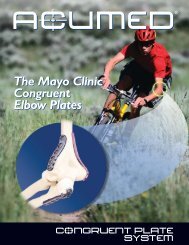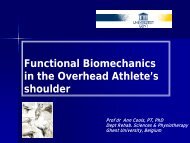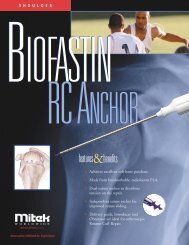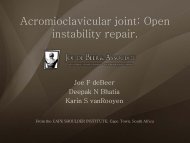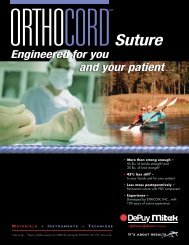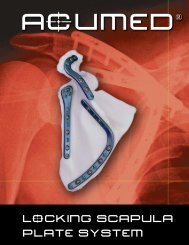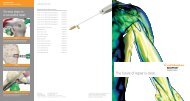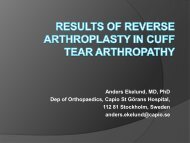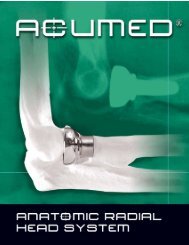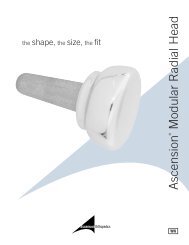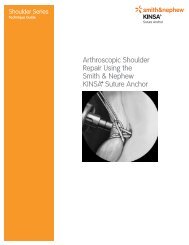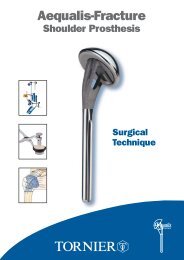Copeland Shoulder, Biomet - ShoulderDoc.co.uk
Copeland Shoulder, Biomet - ShoulderDoc.co.uk
Copeland Shoulder, Biomet - ShoulderDoc.co.uk
- No tags were found...
Create successful ePaper yourself
Turn your PDF publications into a flip-book with our unique Google optimized e-Paper software.
Surgical TechniqueGeneral ConsiderationsThe prosthesis is suitable for insertion via either technique:A. The standard anterior deltopectoral approachB. The antero-superior “Mackenzie” 5 approachThe advantages of the antero-superior technique are:• Smaller and more <strong>co</strong>smetic scar• Quicker post-operative re<strong>co</strong>very• Easier access via rotator interval• Easier access for glenoid resurfacing• Better access to re<strong>co</strong>nstruct the posterior and superiorrotator cuff•␣ Easy access for acromioplasty and excision arthroplastyof the acromioclavicular (AC) joint, if indicatedIf the rotator cuff is intact or a repairable rotator cuff defect is seen, then ananterior acromioplasty can be made with partial resection of the<strong>co</strong>ra<strong>co</strong>acromial ligament. (The <strong>co</strong>ra<strong>co</strong>acromial arch is left undisturbed if thereis <strong>co</strong>mplete loss of rotator cuff.) If preoperative X-rays have indicated anarthritic change at the acromioclavicular joint and symptoms suggest this isa site of pain, then an excision arthroplasty can be done at this stage. (Excisionof the AC joint improves exposure.)Patient PositioningPreoperative Preparationand Patient PositionPreoperative prophylactic antibiotics should be given intravenouslyeither one hour prior to surgery or at the time of anaesthetic induction. Inpatients who are not sensitive to iodine, a skin pre-preparation using povidoneiodine is performed in the ward prior to surgery.A soaked surgical dressing is placed into the axilla, which may be clipped nomore than 6 hours before the operation.Fig. 1The patient should be placed in a semi-sitting or beach chair position atabout 45° of head-up tilt with the head on a neurosurgical headpiece and thearm on a short arm board attached to the side of the operating table [Fig. 1].It is important to have the patient close to the edge of the table and theshort arm board to permit hyperextension of the arm during surgery to allowdelivery of the humeral head into the anterior wound and to facilitate insertionof the humeral <strong>co</strong>mponent [ Fig. 2 ]. The shoulder blade is best stabilizedby placing a small (500ml) plastic infusion bag or a sandbag under themedial border of the scapula.Fig. 2Routine antiseptic preparation of the skin of the whole of the arm is carriedout. The preparation is <strong>co</strong>ntinued as far proximally as the ear and as fardistally as the breast, as far medially as the midline anteriorly and as far asthe infusion bag or sandbag posteriorly. The forearm and arm should be<strong>co</strong>vered with a sterile stockinette and either an upper limb isolation drape ora “U” drape should be used to provide a safe sterile field. An adhesive plasticsterile drape is then applied to ensure the drapes do not “migrate” duringthe operation.1
Preparation of Humeral HeadThe cannulated spade bit is passed over the guide wire and, using a cannulatedpower drill with a 1/4" Ja<strong>co</strong>bs chuck, the central pilot hole is made downto the “stop” of the bit [ Fig. 13 ]. The bit and guide wire are removed. (Allmorselized bone generated by making this drill hole should be saved andused for later grafting.)Fig. 13The humeral surface cutter is then used to shape the humeral head. The centrallocating peg is directed into the pilot hole and the grater action used toshape the humeral head. The surface cutter is gently pressed down onto thehumeral head such that, while it is rotating, bone appears through all the holesin the surface cutter [ Fig. 14 ]. This facilitates <strong>co</strong>mplete bony apposition to theundersurface of the prosthesis. The surface cutter also delineates the edge ofwhere the prosthesis will meet the bone. This marks further bone to beremoved from the periphery of the head using a small osteotome or bonenibblers. The edge of this cut now appears beneath the normal surface of thebone. Note: The hard osteochondral plate should be left intact, if possible, asthis provides good prosthetic support.It is intended that the depth of the prosthesis will build up this new cutsurface back to the normal anatomical surface of the bone. The trial humeralprosthesis is then placed onto the prepared bone and a trial reduction is made[ Fig 15 ]. Stability and range of motion can be tested at this time (i.e. that thehand can easily go to the opposite axilla and at least 30° of external rotationcan be achieved before anterior translocation). The prosthesis is also checkedfor stability in flexion/extension.Fig. 14Fig. 155
Insertion of ComponentThe trial humeral <strong>co</strong>mponent is now removed and the humeral head viewed.Irregularities in the humeral head are routinely grafted using bone fromosteophytes which had previously been removed. Press-fit the <strong>co</strong>mponent byplacing the resurfacing head onto the prepared humeral head and seatingthe <strong>co</strong>mponent about two-thirds of the way with finger pressure. (Whencementing, fill the peg hole with cement before placing the <strong>co</strong>mponent.) Thehumeral prosthesis is then impacted until it is flush against the bone. Whileapplying tension to the subscapularis stay sutures, assess the position ofreattachment of the subscapularis. Usually, because of the resultant lateralizationof the center of rotation, an attempt is made to gain relative length inthe subscapularis. This can be gained in two ways: (1) by performing aZ-plasty on the subscapularis when entering the joint and (2) by medializationof the insertion of the subscapularis to the free edge of the prosthesis[ Fig. 16 ].Fig. 166
ClosureDeltopectoral ApproachThe subscapularis is repaired using No. 1 suture material (absorbable [ PDS ]or non-absorbable) without plicating the subscapularis or with through bonesutures. The rotator interval is closed. If there is any rotator cuff deficiencythen full rotator cuff repair is made in the normal manner at this stage. Everyattempt is made to close the rotator cuff <strong>co</strong>mpletely.The delto-pectoral interval is closed using 2 or 3 interrupted absorbablesutures.Subcutaneous fat is opposed with absorbable sutures and appropriate skinclosure undertaken with Intra-dermal <strong>co</strong>ntinuous absorbable suture(3/0 Monocryl).Antero-superior “Mackenzie”ApproachThe subscapularis is repaired using No. 1 suture material (absorbable [ PDS ]or non-absorbable) without plicating the subscapularis or with through bonesutures. The rotator interval is closed. If there is any rotator cuff deficiencythen full rotator cuff repair is made in the normal manner at this stage. Everyattempt is made to close the rotator cuff <strong>co</strong>mpletely.Fig. 17The deltoid is reattached to the acromion with No. 1 absorbable sutures (PDS)through bone [ Fig. 17 ].The deltoid split is approximated with 2/0 absorbable suture.Subcutaneous fat is opposed with absorbable sutures and appropriate skinclosure undertaken with Intra-dermal <strong>co</strong>ntinuous absorbable suture(3/0 Monocryl).Postoperative ManagementThe patient is placed in a sling with bodybelt and brachial block analgesia isused. Passive mobilizing is re<strong>co</strong>mmended for the first 48 hours and passiveassistance for five days thereafter. Active movements are then started as painallows and the sling abandoned at three weeks. A stretching and strengtheningprogram is then advised standard for all shoulder replacements.7
References1Williams GR, Iannotti JP: “Anatomy and biomechanics of the glenohumeral joint related to shoulder arthroplasty.” Seminars in Arthroplasty 11(1):2-15, 2000.2Boileau P, Walch G: “Three-dimensional geometry of the proximal humerus: Implications for surgical technique and prosthetic design.” J Bone Joint Surg (B) 1997; 79-B: 857-65.3Levy O, Bruguera J, Kelly C: <strong>Copeland</strong> SA: “Cementless surface replacement arthroplasty of the shoulder — 11 years experience.” ICCS, Sydney, 1998.4Levy O, <strong>Copeland</strong> SA: “Cementless surface replacement arthroplasty of the shoulder: 5 to 10 year results with the <strong>Copeland</strong>, Mark-2 prostheses.” J Bone Joint Surg (B), 2000; 83-B: 213-21.5Mackenzie DB: “The antero-superior exposure for total shoulder replacement.” Orthop. Traumatol 1993; 2:71-7.This brochure describes the surgical technique used by Steven A. <strong>Copeland</strong>, F.R.C.S. <strong>Biomet</strong>, as the manufacturer of this device, does not practice medicine and does not re<strong>co</strong>mmend this or anyother surgical technique for use on a specific patient. The surgeon who performs any implant procedure is responsible for determining and using the appropriate techniques for implanting theprosthesis in each individual patient. <strong>Biomet</strong> is not responsible for selection of the appropriate surgical technique to be used for an individual patient.The <strong>Copeland</strong> Surface Replacement Arthroplasty (CSRA) of the shoulder was developed by Steven A. <strong>Copeland</strong>, F.R.C.S., Consultant Orthopaedic Surgeon at the RoyalBerkshire Hospital, Reading, England, U.K.This device is intended to be used in the United States as described in the product labeling.<strong>Copeland</strong> and MacroBond ® are trademarks of <strong>Biomet</strong>, Inc.8
Humeral Resurfacing HeadTM
P.O. Box 587, Warsaw, IN 46581-0587 • 219.267.6639 ©2001 <strong>Biomet</strong> Orthopedics, Inc. All Rights Reservedweb site: www.biomet.<strong>co</strong>m • eMail: biomet@biomet.<strong>co</strong>mForm No. Y-BMT-725/093001/M



